The Twenty-first Annual ACM International Collegiate
Programming Contest Finals
sponsored by

Problem G
Spreadsheet Tracking

Problem G
Spreadsheet Tracking
Some spreadsheets allow users to mark collections of rows or columns for deletion, so the entire collection can be deleted at once. Some (unusual) spreadsheets allow users to mark collections of rows or columns for insertions too. Issuing an insertion command results in new rows or columns being inserted before each of the marked rows or columns. Suppose, for example, the user marks rows 1 and 5 of the spreadsheet on the left for deletion. The spreadsheet then shrinks to the one on the right.
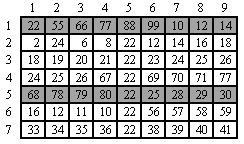
| 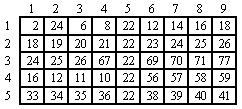
|
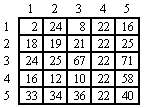
If the user marks rows 2, 3 and 5 for insertion, the spreadsheet grows to the one on the left. If the user then marks column 3 for insertion, the spreadsheet grows to the one in the middle. Finally, if the user exchanges the contents of cell (1,2) and cell (6,5), the spreadsheet looks like the one on the right.
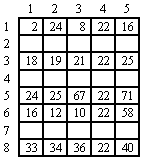
| 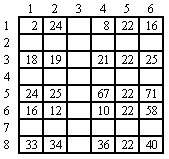
| 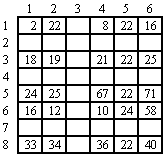
|
An operation to exchange the contents of cell (r1,
c1) with the contents of cell
(r2, c2) is given by:
EX r1 c1 r2 c2
<command> A x1 x2 ... xAwhere <command> is one of the four commands; A is a positive integer less than 10, and x1, ... xA are the labels of the columns or rows to be deleted or inserted before. For each insert and delete command, the order of the rows or columns in the command has no significance. Within a single delete or insert command, labels will be unique.
The operations are followed by an integer which is the number of queries for the spreadsheet. Each query consists of positive integers r and c, representing the row and column number of a cell in the original spreadsheet. For each query, your program must determine the current location of the data that was originally in cell (r,c). The end of input is indicated by a row consisting of a pair of zeros for the spreadsheet dimensions.
For each spreadsheet, your program must output its sequence number (starting at 1). For each query, your program must output the original cell location followed by the final location of the data or the word GONE if the contents of the original cell location were destroyed as a result of the operations. Separate output from different spreadsheets with a blank line.
The data file will not contain a sequence of commands that will cause the spreadsheet to exceed the maximum size.
Sample Input7 9 5 DR 2 1 5 DC 4 3 6 7 9 IC 1 3 IR 2 2 4 EX 1 2 6 5 4 4 8 5 5 7 8 6 5 0 0 |
Output for the Sample OutputSpreadsheet #1 Cell data in (4,8) moved to (4,6) Cell data in (5,5) GONE Cell data in (7,8) moved to (7,6) Cell data in (6,5) moved to (1,2) |